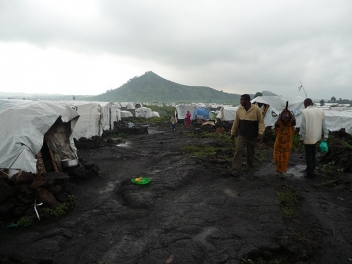 I take stock of what I’ve learned in both the temporary settlements and the official camps. The data available is poor.
I take stock of what I’ve learned in both the temporary settlements and the official camps. The data available is poor.
No one knows how many are still in the villages which won’t be accessible to NGOs until security improves.
I know that in some places, such as Mai Mai, people believe they are protected from bullets and combat death, many more young men have stayed behind.
Lack of data
Before I arrived, HelpAge International and their local partner ABIPA did collect some data from the spontaneous settlement sites in Goma. This could not have been an easy task because people arrive and leave freely and mix with the local population.
In the camps, the percentage of older people is pretty low. In Bulengo for example, it’s about 0.8%. In Mugunga 3, the camp manager had not finished collecting the data so I quickly added up everything he had on several loose pieces of paper and worked out 3-4% – hardly reliable!
So I need to understand the situation through all the anecdotal evidence I’ve gathered in interviews, case studies and conversations with agency workers and camp managers.
Too frail to travel
Everyone I’ve spoken to so far agrees that many stayed in their villages either because they were too frail to travel or simply because they don’t want to abandon their homes. Often, it’s the only place they know; it is where they were born and where they will die. It is their land and livelihood and leaving is out of the question.
I’ve learned that they are not always targeted by rebels so some have their houses intact whilst the rest of the village was either burned down or pillaged. I’ve also learned that their living conditions are dire, especially sanitation and nutrition, but they tend to stay together in close-knit communities and gather in more convenient areas by the side of the roads or whichever part of their village was least affected.
Pillars of their communities
They support each other and share difficult tasks such as fetching water and wood for their fires. In many cases, there are networks of younger people (or not so young, one person I met was 65 years old) who travel back and forth with news and small food rations.
Not everyone from the younger generations have left and some continue to work the fields and manage to sell their harvest in the nearest town (Mai Mai).
I’m beginning to understand that there’s still a lot of respect for older people in Africa. Out in rural areas, they are the pillars of their communities and are rarely completely cut off and abandoned.
More about my visit to Bulengo camp on AlertNet
Read more about HelpAge’s work in DR Congo.
